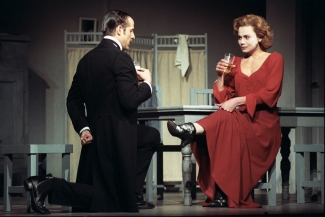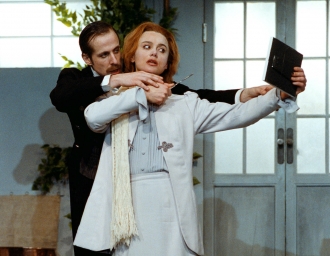Miss Julie
Bergman's production closely follows Strindberg's original directions.

'Ingmar Bergman crashes onto the Small Stage of the Royal Dramatic Theatre, making the kitchen walls of the manor house rumble and the copper saucepans rattle on the chimney-piece [...] There is kissing and fighting, intensifying by degree, in violently physical acting. The spectator is witness to drunkenness, fondling and fornication.'Hans-Christer Sjöberg
Reviews and comments
Writing in Expressen, Lisbet Larsson saw the production as an intensive portrayal of Julie's increasingly angst-ridden decline towards 'total powerlessness, voluntary surrender'. Unequivocally, she also saw Julie's fate as the focal point of the production. 'This is truly Miss Julie's performance in all respects, formed like a Greek tragedy rather than a naturalistic tale of anguish.' And she proclaims that 'Marie Göranzon is splendid'. The disadvantage of this strong focus on the fate of Julie, according to Larsson, is that there is never any really dynamic interplay between Jean and Julie. As such, Jean can never be anything more than a bit player in the inner workings of Julie's mind. The two of them are, in effect, incapable of touching each other.
Not all critics, however, were convinced of the success of this intensive element in the play. Some were of the opinion that it was unsuitable for the Small Stage of the Royal Dramatic Theatre, accusing Marie Göranzon of a mannered, over-acted performance.
Ingmar Björkstén, writing in Svenska Dagbladet, summed up Bergman's production as follows.
There are times when his Miss Julie and Jean shriek at such a high volume that they are bound to wake not only Kristin [...] but the whole household. On the Small Stage, this is too heavy handed. Overblown expressions of emotion disturb. Nuances are drowned in noise, alienating the audience from involvement.
Dagens Nyheter's Lars Linder was of the opinion that Bergman's interpretation of such a highly-strung Julie does no favours to the character herself.
With her epilepsy and the like, she seems to be a study in theatrical psychology; tossed between frigidity, breakdown and struggle, a study in extremes. Marie Göranzon does make her convincing, occasionally on the edge of overacting. She is certainly not a Julie who wins the understanding and sympathy of the audience.
Some critics saw Jean as the central figure of the production, the character from whom the real dynamism stems. Many were impressed by the virility and power of Stormare's performance; this is no cheap ladies' man, but a man with an accustomed elegance in his manner, a man who also displays calculating and cold indifference to a Julie who allows herself to be humiliated.
On the other hand, 'Jean behaves like an amazingly considerate person', wrote Lars Linder in Dagens Nyheter, who regarded Stormare's performance as one of the unexpected high spots in the production. Linder also saw a logic in the way that Julie is presented in relation to Jean. 'In order for the action, despite this compassionate Jean, to be driven to its dreadful conclusion, Julie needs to be just as highly-strung and terrified as Marie Göranzon is required to make her.'
But not all critics appreciated Stormare's performance. Arbetet's Bertil Palmqvist thought him odd. 'He is a rather affected actor with a tendency to overact, sometimes almost appearing amateurish.'
Many critics noted that in Bergman's production, Kristin, played by Gerthi Kulle, has a more commanding role than usual. As such, the production can be seen as a triangle drama. Kristin, a worthy rival to Julie, is presented as a woman of warmth and vitality, smitten with her Jean and looking forward to their night of passion ahead. At the end of the play she is more like 'a revenging angel than the mild person her name would imply' (Lisbet Larson).
Tomas Bredsorff, writing in the Danish Politiken, thought that Kristin, in this production, held the real power - she knows that she has the upper hand with Jean where Julie is concerned.
Sources
- The Ingmar Bergman Archives.
- Henrik Sjögren, Lek och raseri, Ingmar Bergmans teater 1938-2002, ( Stockholm: Carlsson Bokfölag, 2002).
- Birgitta Steene, Ingmar Bergman: A Reference Guide, (Amsterdam University Press, 2005).
There were only a few performances of Miss Julie at Dramaten before it went on tour to 14 places in Sweden.
Spain, Madrid, International Theatre Festival, 28 February-3 March 1986
Four performances were recieved with much applause. However, the murder of Swedish prime minister Olof Palme shifted the press attention to the political events.
Finland, Vasa, Wasa Teatern, 15-17 April 1986
The three performances were sold-out and the reviews were enthusiastic.
Iceland, Reykjavik, 7-8 June 1986
Bergman made a rare appearance and at the press conference he talked about the different versions of Strindberg's manuscript and about his love of the theatre, referring to his stagecraft as 'a natural, simple, unneurotic and creative process'.
Canada, Quebec International Theatre Festival, Grand Theatre, 12-14 June 1986
The three performances of the Dramaten production of Miss Julie did not play full houses, though it received standing ovations in the Grand Theatre.
Italy, Spoleto Music and Theatre Festival, 23, 25, 27 June 1986
Included in the festival was a retrospective showing of selected Bergman films.
Scotland, Edinburgh, King's Theatre, 30 August-1 September 1986
The Royal Dramatic Theatre performance took place in the renovated King's Theatre, where accoustic problems with the loudspeakers caused simultaneous translation to echo on stage. The critics don't seem to have been bothered. Michael Billington in The Guardian wrote, 'Bergman makes us see Strindberg with completely new eyes'. In The Observer Michael Ratcliffe established, 'Miss Julie emerges as a much richer and fuller play than ever before'.
Serbia, Belgrade International Theatre Festival, September-October 1986
In competition with 10 other international guest productions, Bergman's Miss Julie shared the festival's grand prize with a play performed by the Danish Odin Theatre.
8. UK, London, Lyttleton, 17-18 June 1987
Presented together with Bergman's 1986 Hamlet production, the performance aroused none of the critical controversy of this, Bergman's Shakespeare production. On the contrary critics called the performance 'a brand new masterpiece'.
USA, Los Angeles Theatre Festival, James A. Dolittle Theatre, 22-27 September 1987
Praise went to Bergman's development of Kristin's character, with one critic finishing his review with, 'If this were a Bergman film, Julie and Kristin would go off and start the hotel, leaving Jean to shine the master's shoes'.
Japan, Tokyo Globeza Theatre, 27-29 June 1988
Both Bergman's Hamlet and Miss Julie productions were guest performing in Tokyo. Hamlet was sold-out thanks to long-time sponsoring of Shakespeare among Japanese business. The Strindberg play was not as well-known and didn't sell out.
The Soviet Union, Moscow, Mchat Theatre, 21-25 September 1988
The five perfomances were sold-out and on the evening of the opening night people lined up outside the theatre, tore down the barricades and stormed the theatre in their desire to get a hold of tickets. Soon the tickets circulated on the black market.
USA, New York, Brooklyn Academy of Music (BAM), 10-20 June 1991
Miss Julie was one of three Bergman performances visiting BAM.Tthe others were Long Day's Journey into Night and A Doll's House. The three performances of Miss Julie were met with great enthusiasm. Bergman's sense for details was referred to as 'camera-sharp', and one review read 'a great classic text perfectly fulfilled'. Another critic wrote, 'This is an eloquent performance of a masterwork, in every sense a transcendent evening in the theatre'. This Miss Julie was a new, less stylized version of Bergman's 1985 production, now with Lena Olin in the title role. In an interview Olin said that the performance had altered a great deal and called it 'more carnal. It is blood, sweat and tears.'
Collaborators
- Marie Göranzon, Julie
- Peter Stormare, Jean
- Gerthi Kulle, Kristin
- Lena Olin, Julie (1991 revival)
- Eva Callenbo, (unkown part)
- Paula Ternström-Almquist, (unkown part)
- Peter C Blomberg, (unkown part)
- Måns Edwall, (unkown part)
- Lars-Erik Johansson, (unkown part)
- Karl Evert Kevestad, Works manager
- Jan Lundberg, Works manager
- Ulla Åberg, Dramaturgy
- Bengt Wanselius, Stills photographer
- August Strindberg, Author
- Hans-Åke Bergström, Stage manager
- Gunilla Palmstierna-Weiss, Costume design
- Birgit Bohm, Costume manager
- Hans Åkesson, Lightning
- Niklas Engström, Lightning technician
- Anna-Lena Melin, Make-up and wigs
- Katarina Sjöberg, Producer
- Ingmar Bergman, Director
- Anna von Rosen, Assistant director
- Stefan Lundgren, Props
- Bengt Larsson, Master carpenter
- Britta Olin, Prompter
- Bernt Thorell, Technical manager
